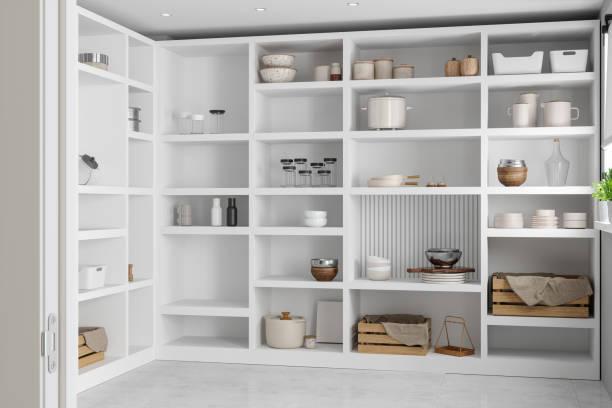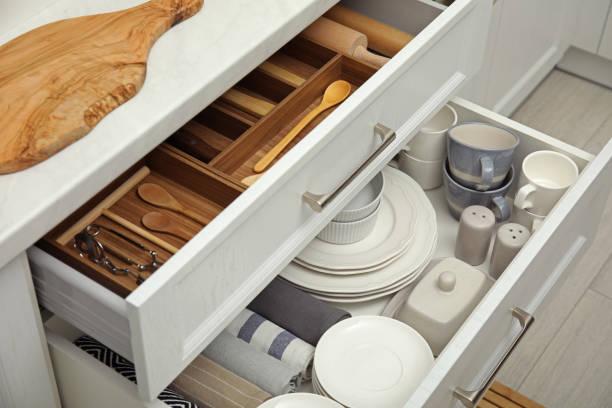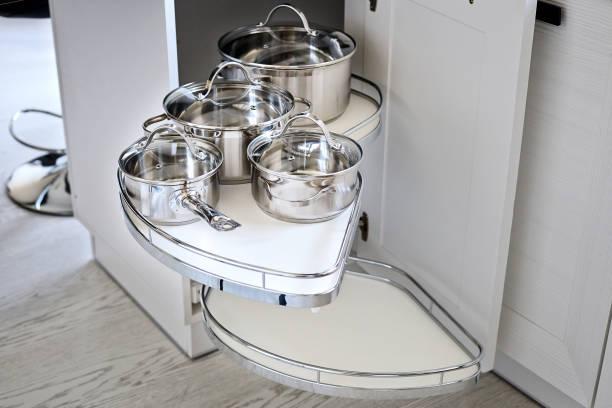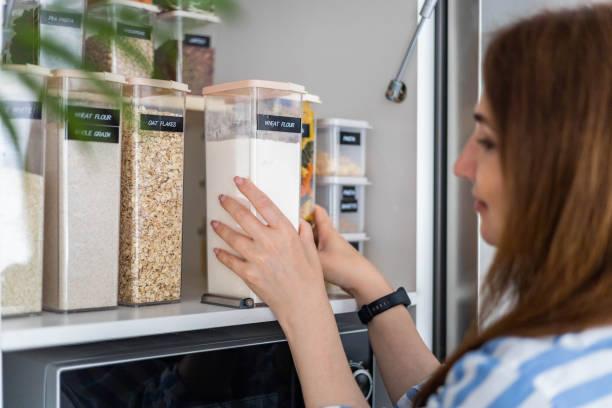Imagine walking into your kitchen, each cabinet neatly arranged, items at your fingertips—the epitome of efficiency. This vision is not just a dream; it’s an attainable reality. Organizing kitchen cabinets maximizes space, reduces time spent searching for items, and transforms your kitchen into a model of functionality. This guide will walk you through how to organize kitchen cabinets, turning cluttered shelves into a well-ordered culinary haven.

Start With a Clean Slate
Before you can organize, you must purge. Empty each cabinet completely and give them a thorough cleaning. This process not only prepares your space for reorganization but also gives you a clear inventory of what you have. Wiping down shelves and drawers with a gentle cleaner can remove dust and grime, setting a fresh foundation for your items to be placed back in an orderly manner.
Declutter and Sort Your Items
As you empty your cabinets, it’s crucial to declutter. Evaluate each item’s necessity by asking: When did I last use this? Is it functional or sentimental? Additionally, apply the Marie Kondo philosophy by considering whether each item “sparks joy.” If an object fails to make you smile or feel a positive emotional connection, it might be time to part ways. Create piles to keep, donate, or discard. Be decisive; holding on to rarely used gadgets or joyless items only perpetuates the clutter.
Categorize and Store Items by Use
Now that you’ve pared down to the essentials, categorize items based on frequency of use to streamline your daily routine. Place daily essentials within easy reach. For instance, everyday dishes, silverware, and your favorite cooking pans should be positioned at arm’s length, ideally at eye level or in lower cabinets for effortless access.
Conversely, items that see less frequent use, such as holiday platters and specialty appliances, should be stored on higher shelves or in out-of-the-way cabinets. This approach helps maintain an organized and clutter-free kitchen environment, ensuring that less frequently used items don’t crowd your prime kitchen real estate. By optimizing the placement of these items, you create a more efficient workspace that supports your culinary endeavors without unnecessary interference.
Utilize Organizing Tools and Accessories
Elevate your kitchen’s organization by incorporating a variety of organizing tools. Shelf risers can dramatically increase your vertical storage capacity, allowing you to stack dishes and containers effectively. Drawer dividers are invaluable for keeping cutlery and gadgets organized, turning a jumbled drawer into a neatly arranged space.

Opt for clear containers for pantry items; these not only help keep ingredients visible and accessible but also preserve freshness. Additionally, consider the use of specialized organizers like step-shelf spice racks and under-sink organizers, which can optimize overlooked spaces and significantly enhance your kitchen’s functionality.
Implement Creative Storage Solutions
Harness your creativity to develop unique storage solutions that reflect your personal style and increase your kitchen’s efficiency. A lazy Susan can revolutionize your access to spices, oils, and condiments, making it easy to find what you need with a simple spin. Installing hooks underneath cabinets or shelves can effectively utilize unused space, offering a perfect spot to hang mugs, utensils, or potholders. These creative touches not only maximize space but also add an element of personal flair to your kitchen’s organization.
Designate Zones for Specific Functions
For maximum efficiency, segment your kitchen into dedicated zones for specific tasks. Establish clearly defined areas for food preparation, cooking, and cleaning, each stocked with the necessary tools and supplies. For instance, create a baking station near the oven with all related ingredients and bakeware, and keep cleaning supplies neatly organized under the sink. This zonal strategy not only makes your kitchen tasks more intuitive but also minimizes time spent searching for items, thereby streamlining your cooking and cleaning processes.

Use Vertical Space Wisely
In small kitchens, vertical space is a precious commodity. Make the most of it with stacking shelves and hanging racks, which provide ample storage without sacrificing counter space. Over-the-door organizers are also excellent for adding extra storage to cabinet doors, perfect for stowing everything from cleaning tools to pantry staples. By thinking vertically, you can greatly expand your storage possibilities, keeping your kitchen orderly and spacious.
Label Everything
The simple act of labeling can profoundly streamline your kitchen organization. Use labels on shelves, bins, and containers to clearly denote where items should go. This practice not only aids in finding and retrieving items quickly but also ensures that every family member knows where things belong, reducing clutter. Especially effective in pantry and spice storage, labels can help maintain order long-term, making it easy to keep up with your organized kitchen.

Maintain Your Organized Cabinets
Organization is not a one-and-done task—regular maintenance is key. Set a schedule to reassess and tidy your kitchen cabinets every few months. This regular upkeep prevents the slide back into disorder and keeps your kitchen functioning at its best.
Conclusion
As we wrap up, remember that learning how to organize kitchen cabinets is more than just a cleaning task; it’s a step towards transforming your kitchen into a more pleasant, productive space. The benefits of a well-organized kitchen are manifold: from enhanced aesthetics to improved functionality and reduced stress. Try out these tips, tailor them to your space and habits, and watch as your kitchen transforms into a model of efficiency and serenity. Why wait? Start your journey to an impeccably organized kitchen today!
FAQs
What is the correct way in organizing kitchen cabinets?
Organize kitchen cabinets by grouping similar items together, such as dishes, glasses, and utensils, to optimize space and accessibility. Store frequently used items at eye level and lesser-used items higher up or in deeper cabinets.
How do I decide where to put things in my kitchen?
Place items in your kitchen based on frequency of use. Everyday items should be easily accessible, while seasonal or rarely used items can be stored in higher or out-of-the-way cabinets.
How to organize a kitchen into zones?
Divide your kitchen into functional zones: cooking (near the stove), preparation (ample counter space), cleaning (around the sink), and storage (cabinets and pantry). This streamlines workflows and reduces unnecessary movement.
How do I maximize my kitchen layout?
Maximize your kitchen layout by ensuring a practical work triangle between the stove, sink, and refrigerator, maintaining clear pathways, and using vertical storage solutions to free up counter space.
